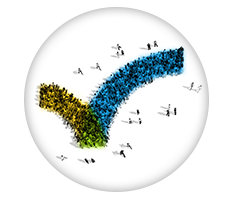How to Use Intent Data to Align Content to Buyer Journey Stages

Be it a blog or Facebook post, the content you share online can make or break buyer engagement, and intent data provides the proof. Content influences the purchasing decision of 62 percent of B2B professionals, according to the 2021 Demand Gen Report.
Clearly, it’s important to set yourself up for success and choose the ideal content at each buyer stage. A content marketing strategy that uses intent signals can address buyer interests more effectively. Intent data helps you choose the content that best resonates with buyer stages.
Intent Data Provides Content Insights across Buyer Journeys
Stage 1: Awareness
A buyer at this stage seeks to uncover the underlying causes of business challenges. They may have little or no insight into available solutions yet. Use this opportunity to share educational resources instead of emphasizing products. Publish content across different platforms, and consider content syndication as one way to achieve this objective.
How to Use Intent Data for Awareness
- Identifying buyer interests: Use topical intent data to identify specific interest within the account that pertains to a specific and or set of related topics
- Discover interest intensity: Intent data scoring provides insight into an increasing or decreasing level of interest in a topic. Use this information to reassess stage and orient them to appropriate content
- Identifying the required content type: It determines the type of content (top, middle, bottom funnel) the audience requires
- Creating new content: Use the information above to develop content that aligns with buyer needs and addresses issues they are attempting to resolve
Stage 2: Exploration
Prospects here have a basic understanding of their challenges and causes. At this point, distribute articles and videos featuring “how-to” guides, checklists, and other more educational content that starts to build out a full solution picture.
How to Use Intent Data for Exploration
- Finding active accounts: Identifying accounts that are actively engaging with content lets you prioritize and create content to engage them.
- Choosing the best email nurture path: Weigh prospects’ content interest against their overall search activity to find the right email nurturing path.
- Consider programmatic advertising to further surround prospects with specific messages and lift other channels.
Stage 3: Consideration
As potential buyers consider your product and others like it, use your content to bridge the gap between marketing and sales-enablement assets. This content should provide a smooth hand-off to sales as they begin to engage.
How to Use Intent Data for Consideration
- Personalizing landing pages: Tailor landing pages for accounts based upon products, problems and topics buyers actively research.
- Countering competitive assets: Learn buyers’ interest in competitors’ products to develop content that drives them to your solution. The content may include case studies, comparison guides or live demos.
Stage 4: Decision
In this final stage, content should enhance the value of the buyer's investment and illustrate how future investments will pay off.
How to Use Intent Data for Decisions
- Identify accounts likely to leave: If customers are researching competitive offerings, provide them with suitable content to regain trust. Guides, free samples, or even direct contact with the customer success team might help.
- Find customers ready to cross-sell/upsell: If you have current customers who are exploring new solutions, intent data can reveal these accounts. Engage with them based on topics and interests to find opportunities to gain more share of wallet.
Don’t Post Just Anything!
What content you serve definitely matters. A live demo offer for a top-of-funnel buyer is a waste of resources and engagement opportunity. The following table highlights suggested content for each B2B buyer stage.
Intent-based content marketing gives you a more relevant way to connect with buyers, so capitalize on its benefits. Put together content that stands out from the crowd and strengthens relationships.
Finding the most appropriate content to share is part of setting up a content marketing strategy. Our other blogs discuss a variety of such strategies, including content syndication for improving content reach.

